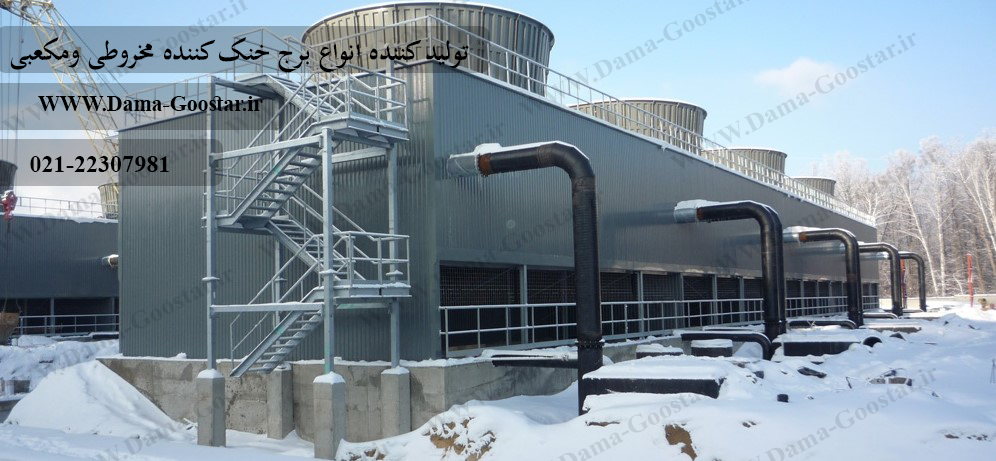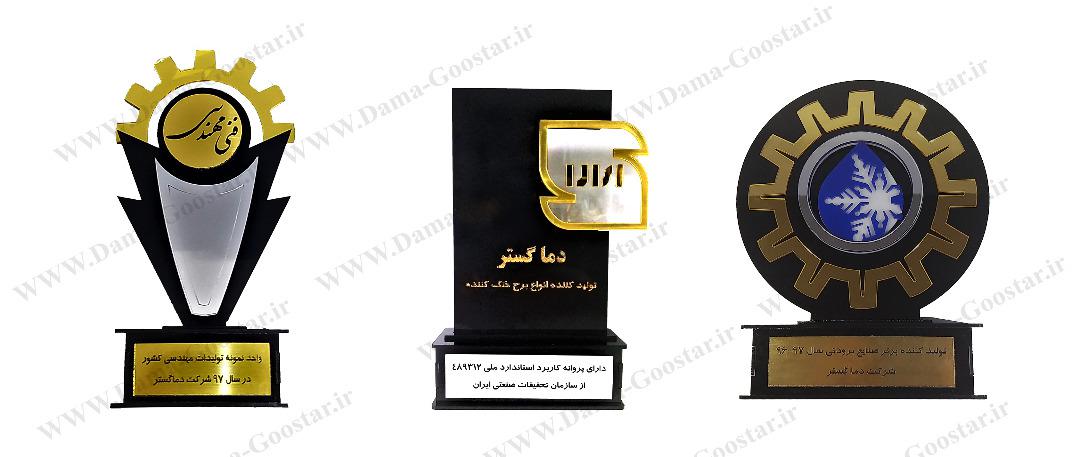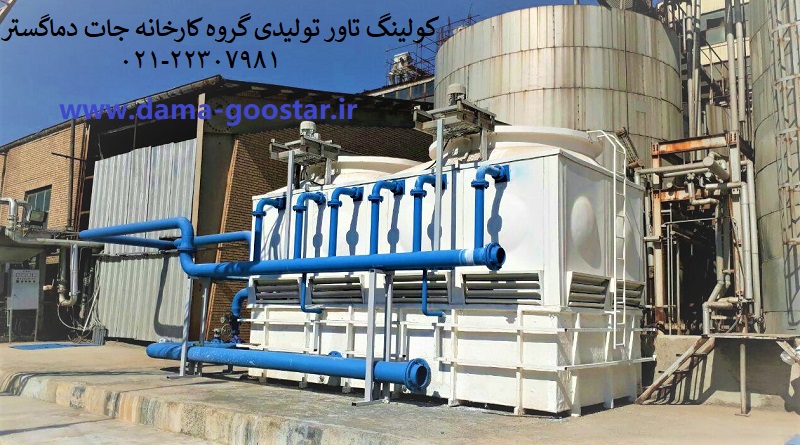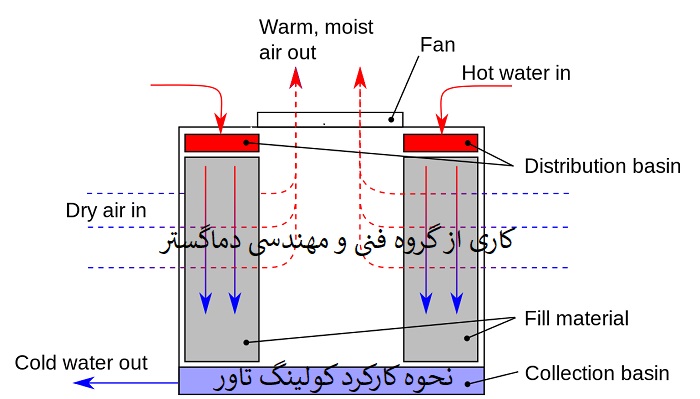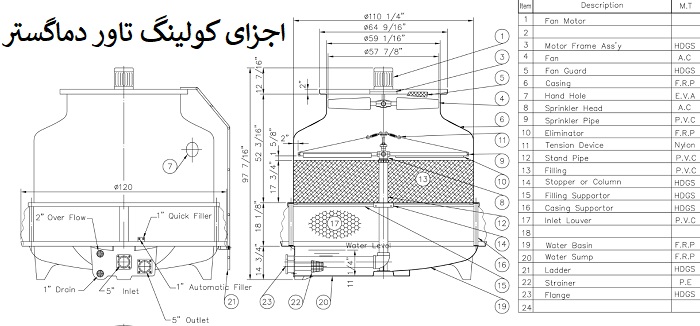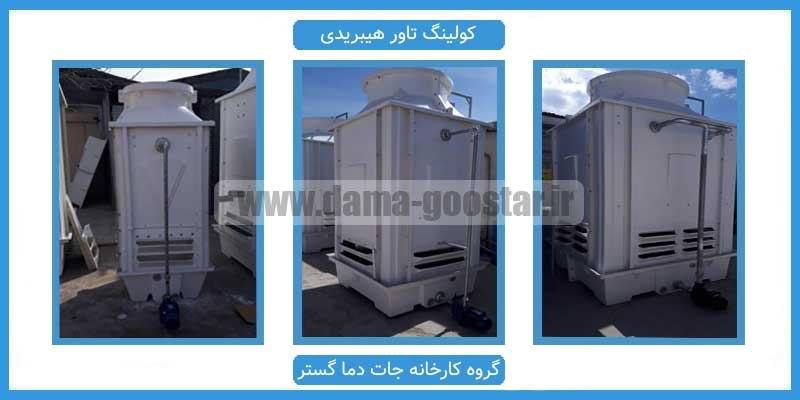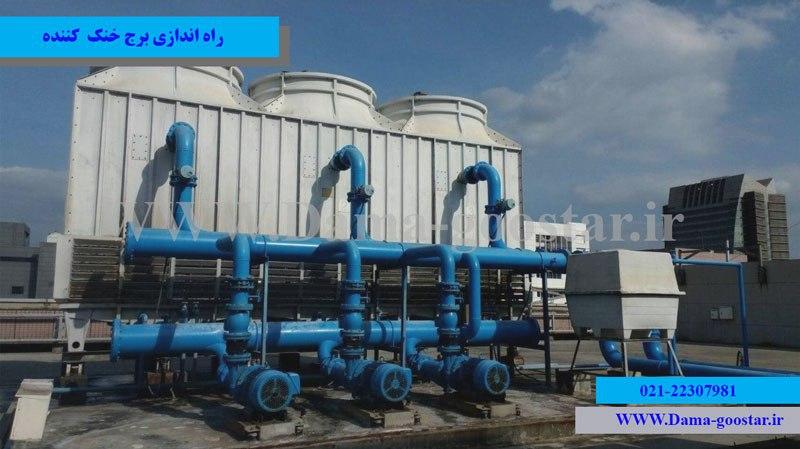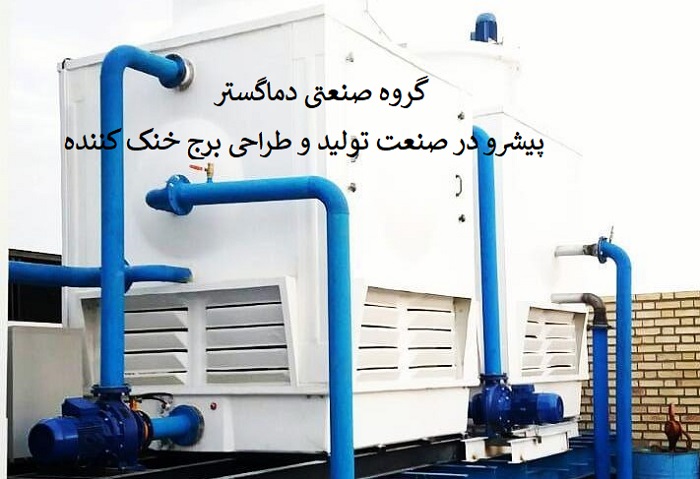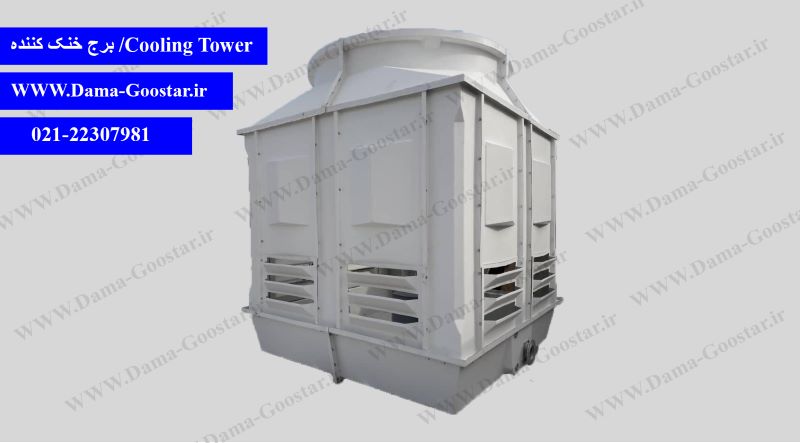
Cooling tower or in the modification of the cooling tower is a water cooling machine, which is also called "water cooling tower" . A cooling tower is a refrigeration machine that is typically used to reduce water temperature to a certain range. The reduction of water temperature in the cooling tower is naturally dependent on the temperature conditions of the installation environment. This cooling machine ( cooling tower) absorbs the heat of the machines by water and directs it to the outside environment.
It is interesting to know that the heat absorbed by the industrial equipment in the internal mechanism of the cooling tower is transferred to the outside by dry air. In other words, a cooling tower is a type of energy exchanger between climates, which is actually called a heat exchanger (heat exchanger). In fact, this refrigeration source exchanges heat energy by making contact and contact between hot water and ambient air. Heat is exchanged from hot water to cool air, which reduces the water temperature.
Why do we use a cooling tower ??
The question may be, why do we use a cooling tower? In response, it should be stated that the cooling tower is complementary to every device and machine that is used in a specific direction. In fact, it should be said that every industrial machine and any device that is used heats up after a while. Air or water is used to cool all industrial machines such as chillers, boilers, etc. The water that absorbs the heat of an industrial machine is heated and needs a device to reduce its temperature again. In other words, the cooling tower (also known as the cooling tower) is responsible for re-circulating water to cool other devices.
*** Take a closer look at the operation of the cooling tower
The cold water produced in the cooling tower re-absorbs the extra energy of the equipment and frequently transfers it to the air. This process is an iterative cycle that keeps the operating temperature of industrial machinery constant . Water cooling tower or cooling tower with continuous production of cold water can take the heat of the chiller, boiler or induction furnace.
Permanent reduction of machine temperature and heat absorption of this equipment is required for system stability. Lack of cold water circulation will increase the temperature of these equipments and their inefficiency. Therefore, the need to use a cooling tower will stabilize the "system" with the highest efficiency. This system may be the air conditioning cycle of a residential, office or commercial building, or the production process of a particular product by an industrial machine.
Method of calculating the power or capacity of the cooling tower
The ability of a cooling tower to dissipate heat energy from a water fluid and transfer it to air is called refrigeration capacity or cooling tower capacity . The higher the cooling capacity of the cooling tower, the more water it will be able to bring to the desired temperature at a given time. The type of cooling fluid, the amount of fluid volume in rotation and the difference between the inlet and outlet temperatures of the fluid in the cooling tower are the main factors determining the capacity. The volumetric rate of circulating water is also called water flow rate. Of course, the ambient temperature factor, hot and cold water temperature are other factors involved in the design conditions. The difference between the inlet and outlet temperatures of the fluid is called the deltati or range.
Determining characteristics of cooling tower capacity
Circulating fluid flow rate (nominal fluid flow)
Type of coolant and determination of specific heating capacity
Fluid inlet and outlet temperature (outlet temperature depending on the design environment)
Design impact factor in calculating the nominal capacity and separating it from the actual power
Methods of calculating the cooling capacity of the cooling tower
More information in the cooling tower calculations section
What is the meaning of refrigeration in the cooling tower?
You must have heard many times that the capacity of the tower is equal to 100 tons or the capacity of a specific model of chiller is equal to 200 tons. The word "ton" in the cooling tower and chiller means the same cooling capacity of the device in cooling water. The word body in this engineering term is abbreviated to "refrigeration body" or "cold body". Cooling is one of the heat transfer units and a measure of the power of refrigeration devices. The refrigeration ton thermodynamic unit (RT) is equivalent to units such as KW and BTU / H. Each ton of refrigerant is equal to 3.51 kW and is equivalent to 12,000 BTU per hour.
What is the use of a cooling tower?
1- In order to cool various industrial devices
Most industrial machines, such as furnaces, boilers, and turbines, generate some extra heat in their duty cycle. The function of the industrial cooling tower in the cycle of these machines and equipment is to absorb and dissipate the excess heat generated. Gas turbines in refineries, air compressors in power plants and boilers in industry are among the most important cooling equipment with cooling towers. The task of extracting this thermal energy is the responsibility of the air fluid. The use of other refrigeration machines such as chillers is also common in small and large industries. High costs in energy consumption, difficult maintenance of chillers, has made the industry welcome the cooling tower.
2- To cool the air conditioning chillers of buildings in summer
Most large buildings and towers, offices, banks and shopping malls have central air conditioning (HVAC). Concentration or absorption chillers are used in central cooling systems to cool the indoor air. The heat absorbed from a building area by the chiller increases the temperature of this refrigeration machine. Cooling tower is used in this application under the name of chiller cooling tower with the aim of adjusting the chiller temperature . The cooling tower generates cold water and directs it to the condenser, causing the temperature balance of this equipment. It should be noted that only chillers that have a water condenser use a cooling tower in their condenser circuit. Today, most compression chillers and all absorption chillers have a water condenser.
Types of cooling towers

The open cooling tower reduces the water temperature by creating a direct contact exchange surface between air and water. In this cooling tower model, a percentage of water evaporates and enters the inlet air. This causes the surrounding air to become humid or saturated. For this reason, this model is also called the wet cooling tower cooling system . The water coming out of the nozzle or sprinkler starts to fall on the packings in contact with the air and the temperature decreases. Wet systems are also called open circuits because the water cycle takes place in an open cycle.
In this cooling tower model, water is cooled in a completely closed cycle in contact with the dry air of the environment. Hence, this type of refrigeration system is also called dry cooling tower . This type of cooling tower is subject to the noticeable temperature of the installation place (ambient temperature) due to direct contact with the dry air of the environment. Dry or closed cooling tower has heat transfer surfaces such as pipe and fan networks. Water passes through these networks in contact with the air created by the fan or impeller.
- Hybrid cooling tower (hybrid)
The new generation of evaporative refrigeration equipment, which is a combination of open and closed cooling tower, is called hybrid cooling tower . The main stream of water fluid is passed through the thermal penetration surfaces of the coil by a secondary spray stream. In this contact, heat is transferred by penetration and conduction from the hot water of the coil to the cold water of the spray circuit. The big advantage of this cooling tower model is the reduction of water temperature to close to the humid ambient temperature. At the same time, this refrigeration system does not have any sedimentation and evaporation.
Types of cooling towers based on the type of inlet air flow
Canterflow cooling tower has air inlet from all sides of the device in the upper part of the pan and the lower part of the packings. The direction of the incoming air flow to the cooling tower is the opposite flow in the opposite direction to the spray water flow from the nozzle. In this model, air enters from the lower louvers and exits from the upper part of the fan oven. The efficiency of this cooling tower model is very suitable for hot and dry environments. They are widely used in cities such as Yazd, Shiraz, Mashhad, Tehran, Arak and Isfahan where the relative humidity is low. Counterflow systems are more efficient than crossover systems. Of course, the use of these systems in humid and humid areas has little efficiency.
Cross-flow cooling tower or vertical flow has two main air inlets on both sides. The air entering this section perpendicular to the water flow causes this fluid to cool. Cross-flow cooling tower performs well in humid areas due to fresh air contact throughout the Beijing area. In the northern and southern regions of our beloved country, which due to its proximity to the sea, the humidity of the environment where the cooling tower is installed is high. In such climatic zones, cross-flow or Abara cooling towers are used. Cities such as Ahvaz, Mahshahr, Bushehr, Rasht, Gorgan, etc. are very suitable for using this device. This model was first conceived by the Japanese company Abara. For this reason, such refrigeration systems are also called Abara cooling towers.
